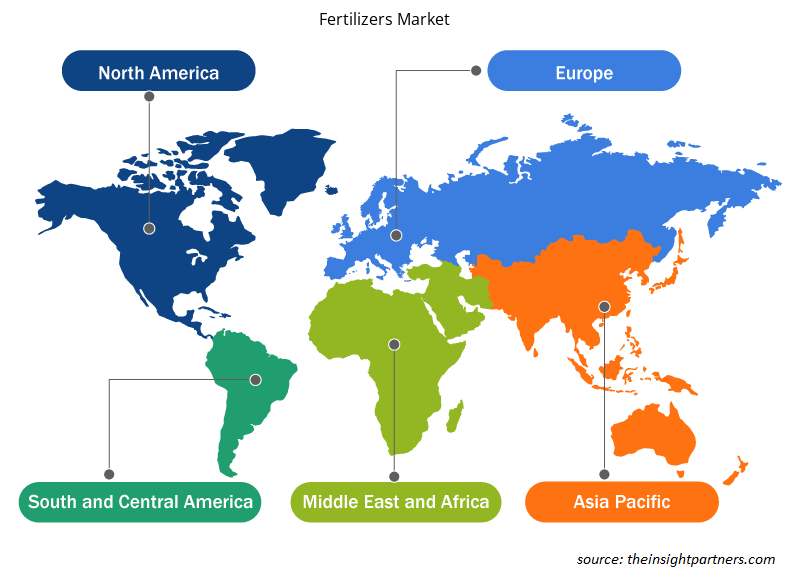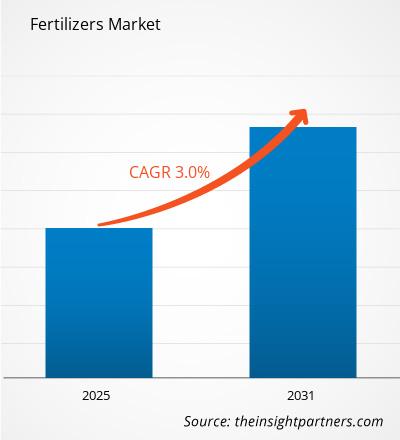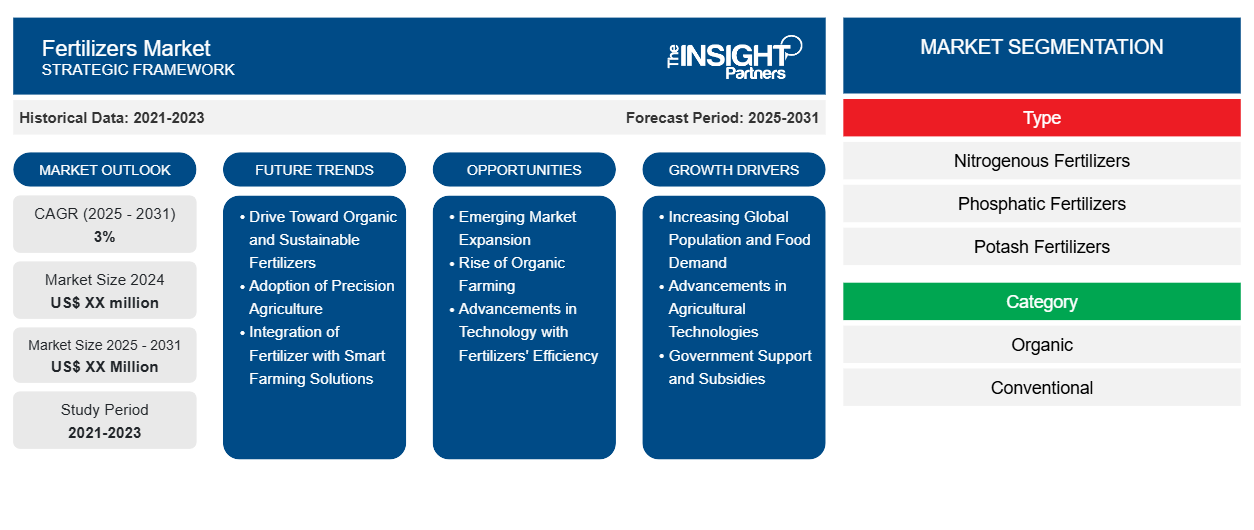肥料市場は、 2024年から2031年にかけて3%のCAGRを記録し、市場規模は2024年のXX百万米ドルから2031年にはXX百万米ドルに拡大すると予想されています。
肥料市場は、タイプ別(窒素肥料、リン酸肥料、カリ肥料、微量栄養素肥料、その他)、カテゴリ別(有機および従来型)、形態別(液体、乾燥、粒状)、作物タイプ別(穀類および穀物、油糧種子および豆類、果物および野菜、その他)、および地域別(北米、ヨーロッパ、アジア太平洋、中東およびアフリカ、および中南米)の分析をカバーしています。肥料は、農業生産者や農家が作物の収穫量を増やし、すべての作物の全体的な健康を向上させるために一般的に使用されています。肥料は土壌に肥料を加え、植物にとって必須の栄養素の重要な供給源として機能します。
報告書の目的
The Insight Partners の肥料市場レポートは、現在の状況と将来の成長、主な推進要因、課題、機会を説明することを目的としています。これにより、次のようなさまざまなビジネス関係者に洞察が提供されます。
- テクノロジープロバイダー/メーカー: 進化する市場の動向を理解し、潜在的な成長機会を把握することで、情報に基づいた戦略的意思決定が可能になります。
- 投資家: 市場の成長率、市場の財務予測、バリュー チェーン全体に存在する機会に関する包括的な傾向分析を実施します。
- 規制機関: 市場の濫用を最小限に抑え、投資家の信用と信頼を維持し、市場の完全性と安定性を維持することを目的として、市場における政策と警察活動を規制します。
肥料市場のセグメンテーション
タイプ
- 窒素肥料
- リン酸肥料
- カリ肥料
- 微量栄養素肥料 Fertilizers
カテゴリ
- オーガニック
- 従来の
形状
- 液体
- ドライ
- 粒状
作物の種類
- 穀物
- 油糧種子および豆類 and Pulses
- 果物と野菜
要件に合わせてレポートをカスタマイズする
このレポートの一部、国レベルの分析、Excelデータパックなど、あらゆるレポートを無料でカスタマイズできます。また、スタートアップや大学向けのお得なオファーや割引もご利用いただけます。
-
このレポートの主要な市場動向を入手してください。この無料サンプルには、市場動向から見積もりや予測に至るまでのデータ分析が含まれます。
肥料市場の成長要因
- 増加する世界人口と食糧需要: 世界の人口が増加するにつれて、食糧生産の必要性が高まります。増え続ける人口の食糧需要の増加を考えると、作物の収穫量を増やし、結果として農業における食糧の安全保障を高める上での肥料の役割は十分に認識されています。
- 農業技術の進歩: 精密農業などの現代の農業技術も、肥料の需要を刺激しています。肥料を最大限に活用し、栄養素の供給を最適化し、廃棄物を削減することで、農家は生産性と持続可能性の向上のために革新的な肥料を採用するようになります。
- 政府の支援と補助金: 各国のほとんどの政府は、さまざまな補助金やインセンティブを実施することで、農業の発展を促進するために肥料の利用を奨励しています。これらの政策により、作物の生産量が増加し、食糧安全保障が改善され、農村経済が発展し、先進国市場と発展途上国市場の両方で肥料の需要が高まります。
肥料市場の将来動向
- 有機肥料と持続可能な肥料への推進: 環境への影響に関する意識が高まるにつれて、農家は化学物質の使用を最小限に抑え、土壌の健康を改善するためのより環境に優しい解決策を求め、消費者の有機農産物の食習慣を考慮して有機肥料市場を支えるようになり、有機肥料の需要が変化しています。
- 精密農業の導入: 今日の肥料市場は精密農業によって定義されています。土壌センサー、GPS、データ分析などを使用することで、直接注入を改善し、無駄を減らして生産性を向上させる能力と組み合わせることで、少量の肥料からより多くの利益を得ることができます。これは、緩効性肥料やカスタマイズされた肥料に対する新しい要件の推進力として機能します。
- 肥料とスマート農業ソリューションの統合: 肥料は、ドローンによる散布や IoT ベースのモニタリングなどのスマート農業技術とますます組み合わされています。これにより、農家は利用可能なリアルタイム データに基づいて肥料の使用を最適化し、環境への悪影響を最小限に抑えながら作物の収穫量を向上させると同時に、肥料の効果を高め、市場の将来の成長を確実にすることができます。
肥料市場の機会
- 新興市場の拡大: 農業が新たなレベルに進化するにつれ、新興経済国では肥料製造に大きな余地が生まれています。これらの市場、特にアジア、アフリカ、ラテンアメリカの市場は、まさに大きな成長の機会を約束しています。農家は、増大する食糧需要を満たしながら作物の収穫量を増やすために、これらの肥料を採用したいと考えています。
- 有機農業の台頭: 有機食品が市場で人気を集めており、需要が高まっているため、有機肥料のチャンスが高まっています。消費者が徐々に健康と環境への意識を高めるにつれて、有機農業のベストプラクティスとともに土壌の肥沃度を高める可能性のある天然肥料の市場が拡大しており、メーカーに成長の可能性を提供しています。
- 肥料の効率に関する技術の進歩: 徐放性肥料や制御放出型肥料などの将来の高度な肥料は、精密農業に可能性を秘めています。これらの製品から得られる利点には、栄養素の無駄の削減、効率の向上、環境に優しい農業慣行の維持などがあります。世界がより優れた、より効率的で環境に優しいソリューションへと向かう中、これは業界にとって大きな成長の機会となるようです。
肥料市場の地域別分析
予測期間を通じて肥料市場に影響を与える地域的な傾向と要因は、Insight Partners のアナリストによって徹底的に説明されています。このセクションでは、北米、ヨーロッパ、アジア太平洋、中東、アフリカ、南米、中米にわたる肥料市場のセグメントと地理についても説明します。

- 肥料市場の地域別データを入手
肥料市場レポートの範囲
| レポート属性 | 詳細 |
|---|---|
| 2024年の市場規模 | XX百万米ドル |
| 2031年までの市場規模 | XX百万米ドル |
| 世界のCAGR(2025年~2031年) | 3% |
| 履歴データ | 2021-2023 |
| 予測期間 | 2025-2031 |
| 対象セグメント |
タイプ別
|
| 対象地域と国 |
北米
|
| 市場リーダーと主要企業プロフィール |
|
肥料市場のプレーヤー密度:ビジネスダイナミクスへの影響を理解する
肥料市場は、消費者の嗜好の変化、技術の進歩、製品の利点に対する認識の高まりなどの要因により、エンドユーザーの需要が高まり、急速に成長しています。需要が高まるにつれて、企業は提供品を拡大し、消費者のニーズを満たすために革新し、新たなトレンドを活用し、市場の成長をさらに促進しています。
市場プレーヤー密度とは、特定の市場または業界内で活動している企業または会社の分布を指します。これは、特定の市場スペースに、その市場規模または総市場価値に対してどれだけの競合相手 (市場プレーヤー) が存在するかを示します。
肥料市場で事業を展開している主要企業は次のとおりです。
- ケリーグループ
- タラカン・アンド・カンパニー
- ADM、
- シナジー
- フレーバーズ株式会社
免責事項:上記の企業は、特定の順序でランク付けされていません。

- 肥料市場のトップキープレーヤーの概要を入手
主なセールスポイント
- 包括的なカバレッジ: レポートでは、肥料市場の製品、サービス、タイプ、エンドユーザーの分析を包括的にカバーし、全体的な展望を提供します。
- 専門家による分析: レポートは、業界の専門家とアナリストの深い理解に基づいてまとめられています。
- 最新情報: このレポートは、最新の情報とデータの傾向を網羅しているため、ビジネスの関連性を保証します。
- カスタマイズ オプション: このレポートは、特定のクライアント要件に対応し、ビジネス戦略に適切に適合するようにカスタマイズできます。
したがって、肥料市場に関する調査レポートは、業界のシナリオと成長の見通しを解読し理解する道の先導役となることができます。正当な懸念事項がいくつかあるかもしれませんが、このレポートの全体的な利点は欠点を上回る傾向があります。
- 過去2年間の分析、基準年、CAGRによる予測(7年間)
- PEST分析とSWOT分析
- 市場規模価値/数量 - 世界、地域、国
- 業界と競争環境
- Excel データセット
最新レポート
関連レポート
お客様の声
購入理由
- 情報に基づいた意思決定
- 市場動向の理解
- 競合分析
- 顧客インサイト
- 市場予測
- リスク軽減
- 戦略計画
- 投資の正当性
- 新興市場の特定
- マーケティング戦略の強化
- 業務効率の向上
- 規制動向への対応























 無料サンプルを入手 - 肥料市場
無料サンプルを入手 - 肥料市場